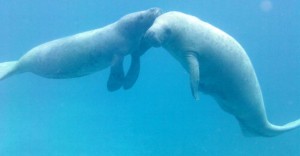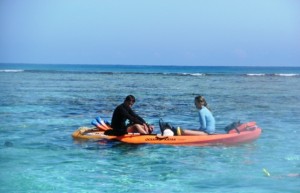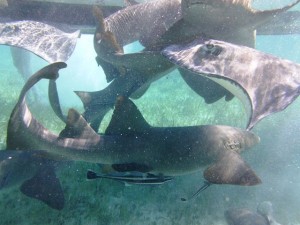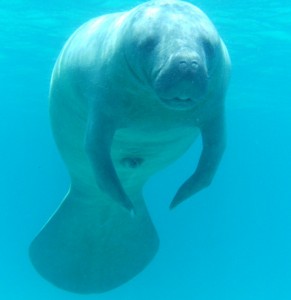The Caye Caulker Marine Reserve was established in May 1998 and is located 1/2 mile east of the island, right in front of us. We wake up to it every day and we hear it when all is quiet on the island. It is beautiful to watch. It protects 5 habitats including mangrove, littoral forest, lagoon marsh-lands, sea grass beds and coral reef. We are so lucky to have this right in front of us. The snorkel trip out to the reef is a must do if you are staying on the island. There is a $10BZD marine reserve fee that is collected by the Park Rangers in the form of tickets, which are purchased at the Hol Chan Marine Office in Caye Caulker located by the police station. We include your ticket in the price of the tour. You can see all of Caye Caulker from the reef. It’s only a 5 minute boat ride away to reach Shark and Ray Alley. This stop is so amazing. Nurse Sharks and Sting Rays all start swimming towards the boat as we get a hold of the mooring buoy. They are eager for food, which first started when local fisherman cleaned their catch and it naturally attracted them. At the Northern end of the Reserve, is a channel and it attracts manatees from May until September. If we are lucky we get to see them and snorkel with them. TWO great reason to visit the Caye Caulker Marine Reserve.
Manatees spend most of their time feeding, resting or traveling. They prefer shallow saltwater bays, slow-moving rivers, canals, estuaries and coastal waters. Manatees are quite agile creatures. A manatee uses its flippers and tail to steer itself. It moves its tail up and down to propel its body forward through the water. Manatees can swim vertically and upside down; they can do rolls and perform aquatic somersaults. Their extra-dense bones enable them to stay suspended at or below the water’s surface.
 |
Manatees eat over 60 different species of aquatic and semi-aquatic plants. Their diet includes manatee grass, turtle grass, various species of algae, mangrove leaves, and water hyacinths. They may consume 10% of their body weight daily in vegetation. Their digestive system allows the bacterial breakdown of cellulose in the hind-gut. To accommodate the great volume of high-fiber food they eat, manatatees have intestines up to 150 feet long.
The jointed bones of manatee’s flipper serve a function similar to a human hand. Their structure helps the manatee move through the water, bring food to its mouth, and hold objects. Three or four nails are found at the end of each flipper. Manatees can’t turn their heads: unlike most mammals, they have six rather than seven cervical vertebrae, so they must turn their whole bodies to look round.
Manatees can grow over 13 feet in length and weigh up to 3,500 pounds. Lengths of 10-12 feet and 1000 -1500 pounds for adults are more typical. In spite of their size, manatees have relatively little fat; they are a sub-tropical species very susceptible to cold. Their eyes are small, but eyesight is good.
Manatee vocalizations take the form of chirps, whistles and squeaks. Communication is particularly frequent between mother and calf, or when the water is turbid. Manatees vocalize to express fear, anger, pain or sexual arousal. They are also adapted to hear infrasound frequencies below 20 hertz.
Swimming speeds of up to 20mph have been recorded, but normally manatees prefer to cruise at speeds of at 2-6mph. They will typically surface to breathe through their nostrils every three to five minutes. When they are using a great deal of energy, however, manatees may surface for air as often as every 30 seconds. They can stay submerged for up to 15-20 minutes.
Manatees have a slow reproductive rate. Twins are rare; when they do occur, one calf is suckled on each nipple, located just behind each of the flippers. More normally, one calf is born every 2-5 years. At birth, the calf is around 3-4 feet long. Guided by the mother, it swims to the surface to breathe. The new-born calf weighs about 60-70 pounds. It starts suckling – underwater – a few hours after birth.
The manatee gestation period is over a year, usually around 13 months. Mothers nurse their young for a long period. When they swim together, the baby may hold onto the mother’s back with its tiny flippers. The calf will remain dependent on its mother for up to two years.
Copulation, in various postures, takes place in the water. An oestrous female may be pursued for weeks by several ardent males who compete to mate with her.
Manatees are migratory animals adapted to both saltwater and freshwater habitats. They are also found in the coastal rivers and lagoons of Belize. Manatees can live up to 60 years. They may occasionally be disturbed by crocodiles, and suffer from habitat-degradation, but their only significant predator is Man.











